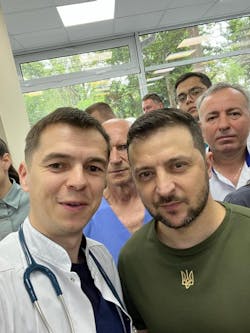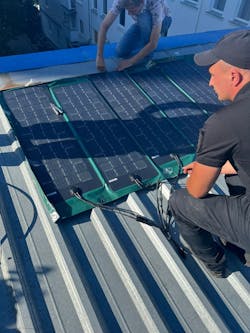Ukrainian and German-Made Solar Microgrids Warm Newborns and Serve Military, Trauma Centers in Ukraine
When Russia invaded Ukraine on Feb. 24, 2022, Will Heegaard and Paul Shmotolokha, a Ukrainian-American, decided they had to take action and began planning to send solar microgrids to Ukrainian hospitals and emergency power equipment to a refugee camp in neighboring Moldova.
Heegaard, operations director of Footprint Project, and Shmotolokha, CEO and director of New Use Energy, which supplies solar generators, first sent six pallets of portable solar microgrid equipment to Ukraine to power medical lighting and communications equipment.
Training Ukrainians to install solar generators
More recently, New Use Energy began training local people to assemble and maintain the solar microgrids and emergency power systems, an effort that helps employ Ukrainians and gets the microgrids on the ground more quickly.
Now New Use Energy, backed by donors, are supplying Ukrainian- and German-made solar microgrids to hospitals, the Ukrainian military and other critical service organizations that desperately need power. The Ukrainian grid is destroyed in some areas, and attempts to rebuild it result in Russian drones dropping grenades on utility workers, Shmotolokha said.
The two organizations have expanded their reach, despite the challenges of operating in a war zone. Footprint Project and New Use Energy can’t use traditional solar collectors because the heat signature would attract the attention of Russian drones that will destroy the panels. In addition, glass panels will shatter when hit by grenades or other weaponry. On-the-ground organizations can’t use natural gas generators because it’s too dangerous to travel for gas supplies and Russian drones will spot and damage the generators, said Shmotolokha.
Installing microgrids wearing body armor and a helmet
Working in a war zone creates many challenges for installers, but they arrive as prepared as possible.
“When my operations director [Oleksii Zemlynskyi] goes out, he’s in body armor and a helmet,” said Shmotolokha. Zemlynskyi, located in Lviv in western Ukraine, is an expert on wiring breakers and fuses.
Portable solar panels designed to withstand dangers of war
Zemlynskyi helps assemble and install the portable units from New Use Energy, which include 300-watt lightweight solar collectors that can be carried under one arm. They can charge outside and be wheeled inside and outside. They include no glass or frame and can be folded up, charged, then moved frequently so that they’re not spotted and damaged by the Russian army, Shmotolokha said. They can’t be shattered. The units generally include 5 kW to 6 kW of solar plus 5 kWh or 10 kWh of storage.
“The biggest challenge is wartime delivery; we try to deliver our goods to places where there is the greatest need for it, and this is often close to the front line, or the front line,” said Zemlynskyi. He often works in and near Kherson, which is on the front line, and where people often don’t have electricity for months because the entire infrastructure is detroyed.
“You cannot be sure of your safety there, because you are always a target for artillery or drones,” said Zemlynskyi.
In some cases, New Use Energy is deploying battery generators; in others, solar is included.
The Ukrainian workers are especially proud of deploying the solar microgrids in hospitals, said Shmotolokha.
Solar generators power incubators and protect newborns
In fact, the units have been moved into hospital bomb shelters to power incubators for newborns. Gas generators can’t be operated in basements because they release fumes.
“We’re out there saving newborns,” Shmotolokha said. “The Ukrainians love building these for us.”
About 15 of the solar microgrids have been built in Ukraine and about 50 in Germany, with more on the way as funding comes in, he said. Ukrainians are also improving on existing solar generators – strengthening them to make them battlefield-ready, for example.
‘Solar doctor’ calls microgrids ‘magic boxes’
In addition to providing electricity for hospital bomb shelters, the solar microgrids are powering a trauma center in Mykolaiv. In that city, the solar generators have been dubbed “magic boxes” by Dr. Dmytro Fedorenko, head of the intensive care unit at Mykolaiv Oblast Hospital and a regional head in the field of anesthesiology. Fedorenko is called the “solar doctor” in Ukraine for his use of the solar generators and he recently received a visit and award from Ukraine President Volodymyr Zelenskyy for his work saving lives during the war, said Shmotolokha.
Projects for the Greater Good are Worth Recognition
Submit Ideas for the Greater Good Awards at Microgrid 2024
The 10-kWh units are especially helpful during long power outages in medical facilities and are often moved to where they’re most needed, including intensive care units or operating wards.
The Ukraine military is also utilizing the units for critical operations, said Shmotolokha. They have been deployed to power communication systems that capture real-time videos of Russian drones. They also power tablets that help run artillery units, drone units and tactical operation centers.
“The greatest need is for the army and medical institutions. The army saves us from the Russians, and the doctors save the lives of all those affected by the conflict,” said Zemlynskyi.
$750,000 in donations from NGOs, suppliers and individuals
New Use Energy has raised about $750,000 to deploy the solar microgrids and battery generators – about 200 to date – as well as help rebuild Ukraine’s electricity system, said Shmotolokha.
Donors are nongovernmental organizations (NGOs), microgrid suppliers and individuals. They include Footprint Project, Rotary International, Schneider Electric, Smart Aid International and Direct Relief. Now Shmotolokha is talking to Doctors Without Borders and the United Ukrainian American Relief Committee about possible donations to the Ukraine effort.
Solar saves money to help pay hospital workers
Such donations not only help protect lives, but they save money and give a hand to the local workforce.
“With the generators, hospitals can generate with solar and pay their employees instead of spending money on fossil fuels,” said Shmotolokha.
Keep track on mission-critical microgrids everywhere by subscribing to our free newsletter
About the Author
Lisa Cohn
Contributing Editor
I focus on the West Coast and Midwest. Email me at [email protected]
I’ve been writing about energy for more than 20 years, and my stories have appeared in EnergyBiz, SNL Financial, Mother Earth News, Natural Home Magazine, Horizon Air Magazine, Oregon Business, Open Spaces, the Portland Tribune, The Oregonian, Renewable Energy World, Windpower Monthly and other publications. I’m also a former stringer for the Platts/McGraw-Hill energy publications. I began my career covering energy and environment for The Cape Cod Times, where Elisa Wood also was a reporter. I’ve received numerous writing awards from national, regional and local organizations, including Pacific Northwest Writers Association, Willamette Writers, Associated Oregon Industries, and the Voice of Youth Advocates. I first became interested in energy as a student at Wesleyan University, Middletown, Connecticut, where I helped design and build a solar house.
Twitter: @LisaECohn
Linkedin: LisaEllenCohn
Facebook: Energy Efficiency Markets



